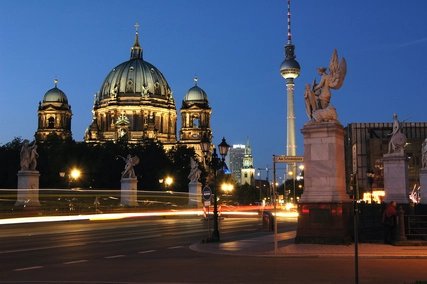
Berlin has more bridges than Venice! In total, there are - depending on the definition - between 960 and 2100. It's not easy to narrow down this selection to the top 11. Therefore, we have left out railroad bridges and bridges that are mainly used by cars. With our selection we want to show you that bridges in Berlin often connect more than just one riverbank with the other. They are meeting places, film locations, the scene of historical events and symbols of the reunited city of freedom.
Tip: From 9 to 15 November, Berlin invites you all to stand up for a just and free world with the first Berlin Freedom Week.
Tip 1: Bösebrücke - first open border crossing after the fall of the Wall

This is where the first GDR citizens streamed westward on November 9. The border crossing at Bösebrücke was the first to open on the day the Wall fell. Today, the arched bridge connects the districts of Gesundbrunnen and Prenzlauer Berg via the mainline and S-Bahn tracks. The steel structure, originally inaugurated as the Hindenburg Bridge, owes its current name to communist resistance fighter Wilhelm Böse.
Tip: Discover more stories and historic insights about the Fall of the Berlin Wall and the Peaceful Revolution in our ABOUT BERLIN app, created especially for Berlin Freedom Week.
Download it now for free!


Tip 2: Glienicke Bridge - the agent bridge

Between 1962 and 1986, high-ranking agents were exchanged several times on the Glienicke Bridge. The exchange of U.S. pilot Gary Powers for top Soviet spy Rudolf Abel in 1962 was filmed in Steven Spielberg's thriller "Bridge of Spies" - of course at the original location. Today, the bridge is especially popular with recreation-seekers. It crosses the Havel River and connects the Wannsee district of Berlin with Potsdam. From here, you can easily reach numerous picturesque destinations on foot or by bike, including Glienicke Palace, the Liebermann Villa and Babelsberg Park, a UNESCO World Heritage Site.
Tip: As part of Berlin Freedom Week, the exciting guided tour "Achtung Sperrzone (Attention restricted zone)" along the Potsdam border strip starts at Glienicker Brücke on Sunday, 9 November 2025, at 11 am.
Tip 3: "Federal Ribbon" Bridge - symbol of reunification
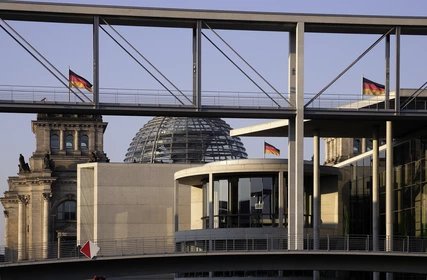
Here at the Band des Bundes ("Federal Ribbon"), parliamentarians stroll back and forth between East and West at lofty heights. The bridge between Paul Löbe House, where members of parliament dine in the canteen, and the Marie Elisabeth Lüders House with its large hearing room, is thus not only practical for the "short official route" but also a symbol of the reunification of the once divided Berlin. All those who did not pursue a higher civil service career can use the lower bridge level.
Tip 4: The palace bridge - Schinkels Schöne
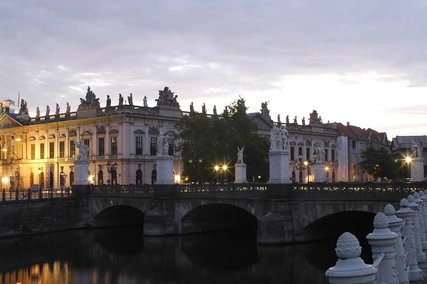
Originally, a simple wooden bridge crossed the western arm of the Spree here. It was mainly used to transport the building materials for the city palace. When the palace was finally built, Friedrich Wilhelm III found the wooden bridge too profane. Master builder Friedrich Schinkel was to create a magnificent work in stone. Although Schinkel's planned group of figures depicting the life of a hero was not completed until after his death, the Schlossbrücke is still considered the most beautiful bridge in Berlin today.
Tip 5: Monbijou Bridge - connection to Museum Island

Especially at sunset, the view of the Bode Museum from here is simply beautiful. The listed Monbijou Bridge connects the Monbijou Park with the Museum Island. The northern part of the double bridge, which was blown up by the Wehrmacht during World War II towards the end of the Battle of Berlin, was reconstructed after the fall of the Berlin Wall. Since the bridge is closed to cars, street musicians often invite you to linger here.
Tip 6: The Moltke Bridge - dedicated to the commander, consecrated to the lovers
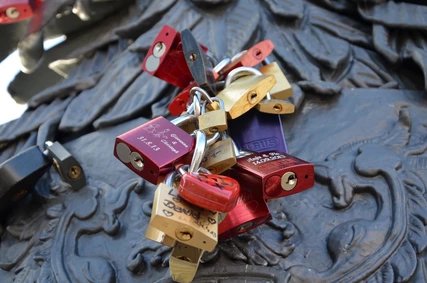
Sculptures of griffin, eagle and owl on the Moltke Bridge symbolize the wisdom and courage of the Prussian commander to whom the bridge is dedicated. On the keystone in the middle arch of the bridge you can even find a portrait of General Field Marshal Moltke (1800 - 1891). By the way, his great-grandnephew was a resistance fighter against National Socialism. The listed Moltke Bridge connects the government district in the Spreebogen with the main train station. Couples like to put their love locks here.
Top 11 Romantic Places in Berlin
Tip 7: Tegel harbor bridge - the bridge of six pence (Sechserbrücke)
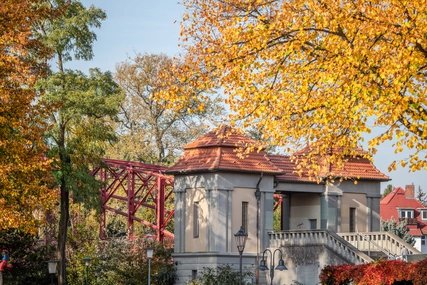
You once had to pay six pennies to cross the Tegel harbor bridge. At the time, this was to refinance the construction costs of the steel truss arch bridge. Today, you walk on the so-called "bridge of six" (Sechserbrücke) over Tegel harbor and the mouth of the Tegeler Fließ. It's a great starting point for excursions, for example to the Greenwichpromenade or the lido at Lake Tegel. Or you can take a hike in Berlin's unspoiled nature. In addition to the Tegeler Fließ, the "Dicken Marie", Berlin's oldest tree, is only a few minutes away on foot.
Tip 8: Oberbaumbrücke - hub for urban art
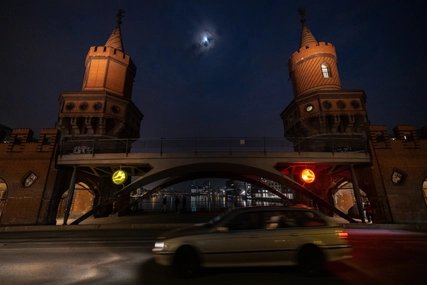
Like the Glienicke Bridge, the Oberbaum Bridge is a popular filming location. For example, it is also crossed by Lola in "Run Lola Run", although it was not really on her route. Well, the Oberbaumbrücke is an unmistakable piece of Berlin. The two neon light boxes, in which one red and one green light hand each play "Rock, Scissors, Paper," are a reminder of the time when it was a border crossing between East and West. This is intended as a symbolic sign against the arbitrariness of political decisions. In addition to the nearby East Side Gallery, you can discover several other exciting urban artworks around the Oberbaumbrücke.
Tip 9: Greifenhagen bridge - walk between art nouveau elements
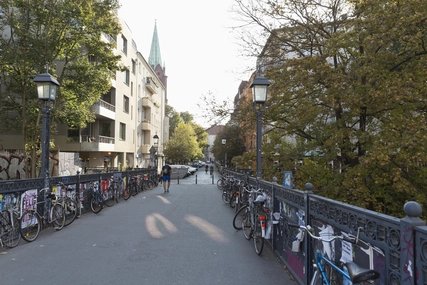
This listed iron truss bridge from 1910 survived both world wars unscathed, as did the Art Nouveau ornaments inlaid in the metal railing and the wrought-iron lanterns. Today, the Greifhagener Brücke serves pedestrians and cyclists as a crossing over the railroad tracks at Schönhauser Allee. Take a look during a stroll through Prenzlauer Berg or a shopping trip on Schönhauser Allee. By the way: The Gethsemanekirche, meeting place of the civil movement and GDR oppositionists in the Wende year 1989, is also very close by.
Tip 10: Modersohnbrücke - hotspot at sunset
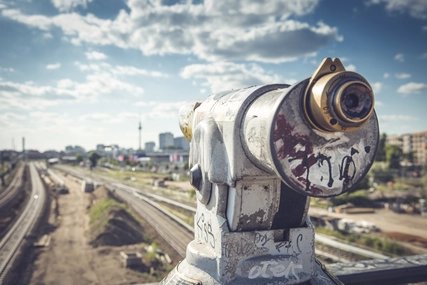
From here you can see the sun setting behind the TV tower. Because of the wonderful view alone, the Modersohnbrücke has long since established itself as an evening meeting place. Street musicians provide the soundtrack for first dates and hours together. Long-distance trains and suburban trains cross below you on their journey. Pure urban romance. We have put together a list of other great vantage points for watching the sunset or just Berlin.
Tip 11: Jannowitzbrücke - most frequented bike route in Berlin
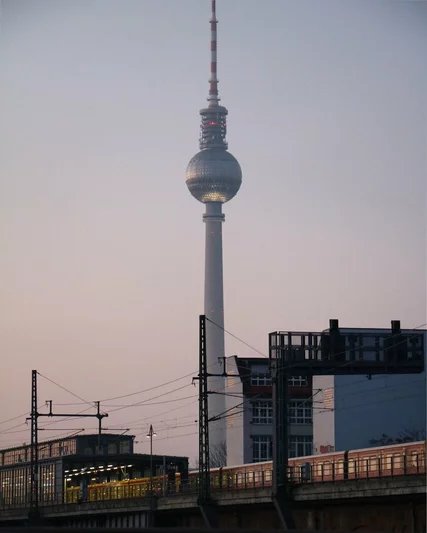
The Jannowitzbrücke is one of the most frequented bike routes in Berlin. From here you also have a great view of the city. It is also exciting what happened under the bridge. Because on August 13, the day the Berlin Wall was built, the entrances to the subway station were closed here, and the train domain to the S-Bahn was even bricked up. Until the fall of the Wall, the station at Jannowitzbrücke was a "ghost station". Two days after the historic November 11, however, the GDR opened the subway station as a border crossing - and East Berliners gained access to West Berlin's public transportation system from here.





